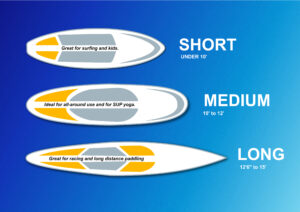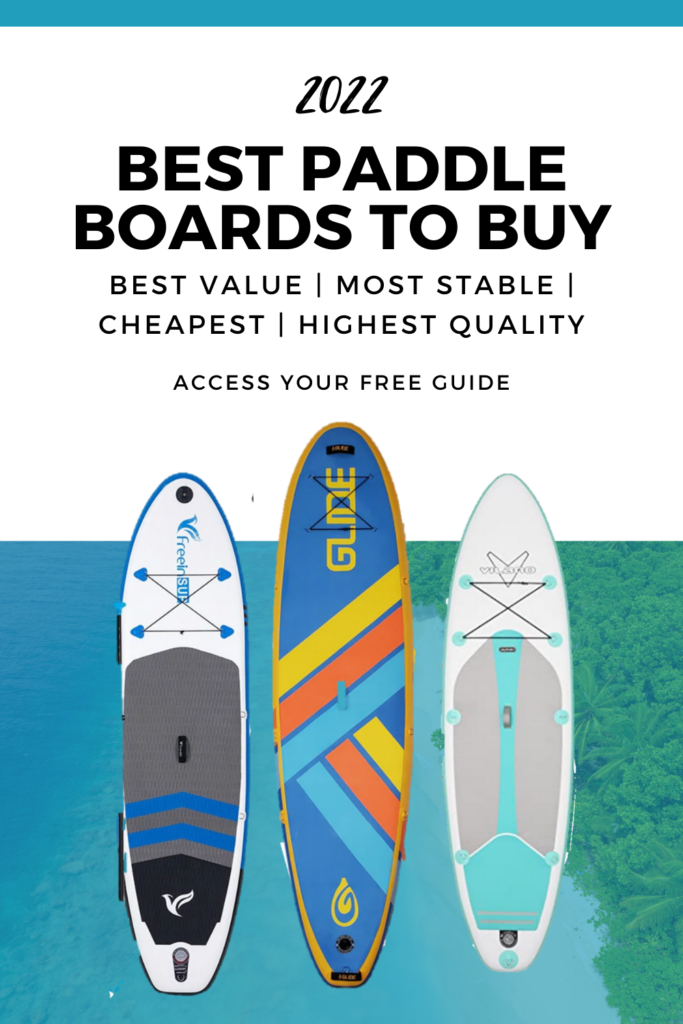In this SUP sizing guide, we’ll walk you through how to choose the right paddle board length, width and height to best suit your paddling style. In addition to helping you get the right length paddle board for your perfect day on the water, we’ll help you understanding what all the SUP measurements mean and why they matter.
Which paddle board length is perfect for you?
So you’ve rented a paddle board at the beach or borrowed a friend’s for a trip around the lake and now you’ve fallen in love with the sport. Before you rush out to your nearest sporting goods store and spend anywhere from $400 to $3,000 on one, it is important to find out which paddle board length suits you.
- This is the perfect guide to help you choose the right paddle board!
While researching and shopping for a stand up paddle board, you will want to consider how you want to use it, your skills, and body weight so that your new SUP provides enough flotation and stability but paddles fast enough and suits the type of paddling you plan to do.
What Sizes / Dimensions Matter For Picking A SUP?


- Length: This refers to the longest dimension of the board from the tip of the front to the very back of the tail.
- Normal measurements usually range from about 8 feet to 14 feet
- Width: This is the measurement perpendicular to the width of the board and is measured at the widest point.
- Standard paddle board widths range from about 25 inches to 36 inches
- Height or Thickness: This refers to how tall the board is from the bottom to the top of the deck.
- Most boards range from about 5 to 8 inches high. This gives a good amount of clearance above the water for a properly loaded board.
SUP Length: Standard Paddle Board Size Categories

Paddle boards typically come in three size categories that range from under 10′ to over 12′ feet. And within these categories you will find boards of almost every size and dimension. If you are shopping for a paddle board or iSUP, you will find that the majority of options fall into the Medium category.
- Short Boards are under ten feet (10′)
- Medium Boards range from ten to twelve feet (10′ – 12′)
- Long Boards are 12’ 6” and up (12’6″ and longer)
How To Determine The Right Paddle Board Length
There are two main factors that go into determining the optimal paddle board length for you. The first is how you intend to use the board and how much maneuverability you want. The second it how much weight your want your paddle board to carry (this includes both your body weight as well as any gear or extras – like a cooler or dog).
How To Accurately Measure SUP Length
Luckily measuring length for paddle boards is fairly easy and standardized across all manufacturers. It’s simply measuring the total length from the very tip of the front, to the furthest point on the tail.
Usually this is just the length straight down the centerline of the board.
How Do You Want to Use Your Board?
Short boards [under 10′] are almost always more maneuverable than longer boards and are perfect for kids thirteen and under. These boards are also great for surfing waves in the ocean.
Medium-sized boards [10′ to 12′] are the most popular type of paddle boards and great for beginners. With a rounder nose and tail, these boards are ideal for calm lakes and rivers, yoga, fishing and paddling around with dogs or children.
Long boards [12’6″+] work great for fast-paddling workouts and touring longer distances. These boards are often faster, offer straighter tracking and are perfect for advanced paddlers.
Why Are Shorter SUPs More Maneuverable?
What does it mean to be a more maneuverable paddle board? When on the water, it refers to how much the board will turn to the left or right of your straight line path with a single stroke.
With shorter paddle boards, there is less of the paddle board sidewall pushing against when water when you paddle, so it will turn faster than a longer board.
Why Are Longer Boards Faster?
Technically this really matters for displacement hull type boards and not planing boards (when they are planing) but odds are you will very often be displacing when you are paddling. As you paddle, your board creates a wave at the bow and then the water dips behind and eventually creates another wave either partially down your board, or if you are at maximum speed – the very tail end of the board.
Paddle board speed is the speed where the bow and tail waves are at the ends of the waterline length of your SUP. On longer SUPs, the bow and tail waves are farther apart. Waves that are farther apart travel faster than waves that are closer together, so a longer boat with it’s longer wave separation has a higher hull speed.
If you really want to start getting into the details of this equation, go for it. But don’t stress about it.
SUP Width: Why It Matters
When choosing your new SUP make sure to consider width. Board width is another important factor that affects how the board handles, how much buoyancy it has and how comfortable it will be to paddle.
- Most paddle boards range from about 25 inches to 36 inches in width.
How To Correctly Measure Width
The width of a board is measured straight across it (perpendicular to the length) at it’s widest point. So despite any taper or shaping of the board, SUP width is simple how wide it is at it’s maximum.
Pros And Cons Of Wider Paddle Boards:
A wider board will always be more stable than a skinny board, but wider sup can be slower and, if the board is too wide for you, difficult to paddle.
- Type of paddling: If you’re going on long tours that require you to carry extra weight in the forms of tents, extra gear, cooler etc. look for a wider board in order to have more storage space. The same is true if you’re doing SUP yoga; a board that is 30 inches wide or more will give you space and stability for doing different yoga poses. Narrower boards, on the other hand, are faster and more maneuverable, making them the choice among racers and surfers.
- Your Body Size: Try to match the width of the SUP to your body type. In general, for smaller or shorter people go with a narrower board and if you’re a taller person, go with a wider board. This is because a smaller person can generally find their balance on a narrow board because they have a lower center of gravity, whereas a taller person may struggle to do so. Also, on a wider board, a shorter person may need to lean further to the side to get the paddle into the water which will results in less effective paddle strokes, poorer stability and potential injury or strain.
- Ability level: If you are an experience paddler, you may be comfortable on a narrower SUP. However, someone brand new to SUP, might prefer a little extra width to help them feel more secure.
It’s important to remember that paddle board width must always be considered in conjunction with length. Board width affects the overall volume and importantly how much weight the board can safely and effectively carry.
SUP Thickness Or Height
What’s the right paddle board height for you? Looking to make sure your toes stay dry? Pay close attention to the details in this section.
How To Measure Board Thickness
Paddle board thickness is measured from the bottom of the board straight up to the top of the SUP deck.
- Most paddle boards range from about 5 inches to 8 inches in height depending on the specific design and style.
We would recommend first focusing on the length & width of board you want based on your paddling style, size and gear carrying needs. After you have determined those – paddle board height can be considered to ensure you get the right amount of volume (weight carrying capacity) to ensure a great paddle experience.
Why Does Board Height Matter?
Too little volume and your board will sit low in the water making it more difficult to paddle, more unstable and more likely for you to get wet.
Too much volume and your board may be overly heavy and difficult to control at times.
How Much Buoyancy Do You Want?
When deciding on the length of your paddle board, it is crucial to ensure the paddle board can carry your weight, any added gear and the weight of any other passengers. You can have the perfect length paddle board but if it can’t support you, it’s worthless.
- Expert Secret Tip: Paddle board manufacturers are notoriously optimistic when ascribing a maximum weight capacity to their boards. If you purchase a board that can’t handle the weight you put on it, the board will sit lower in the water and be more unstable. The increased drag will make it slower and less responsive to your paddling. Worst case is it will sink beneath you. Make sure you find the maximum weight capacity of any board before you purchase it. It’s a good idea to allow some surplus capacity. This will ensure a better paddle boarding experience on the water and will allow for any unplanned weight increases.
Additional Considerations When Choosing A Paddle Board Size
Unless you live on the water, there are two more important items to consider when purchasing your board.
- Storage & Transport Space: Do you have suitable space at home to store a longer board? Can your vehicle handle transporting a longer board?
- Weight and Carrying Ability: Longer boards are also more difficult to carry and not because of the weight but for its sheer size.
Does Inflatable SUP vs. Rigid or Hardboard Matter For Length?
For the most part, the answer is no – when choosing a paddle board length, inflatable vs. hard SUP doesn’t change much. However, inflatable sups offer slightly more stability and buoyancy over a hard board for the same length and width dimensions.
Why are inflatable SUPs a bit more stable? The reason is because hardboard SUPs are much more shaped with curved edges and tapers – while inflatables tend to be a bit more square or blocky. That leaves them with a bit more flotation.
The tradeoff is that the hardboards are often a little faster or smoother when paddling because they are shaped more specifically for ease of use.
